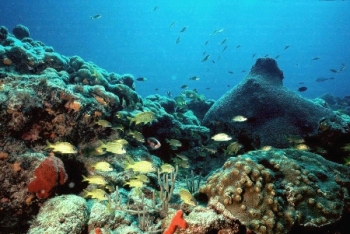|
Southeast Florida’s reefs support a rich and diverse assemblage of stony corals, octocorals,
macroalgae, sponges, and fishes. They span from the northern border
of Biscayne National Park in Miami-Dade County to the St. Lucie
Inlet in Martin County. The Coral Reef Conservation Program (CRCP) coordinates research and
monitoring, develops management strategies, and promotes partnerships to protect the coral reefs, hardbottom
communities, and associated reef resources of southeast Florida.
|
|
Through its role in supporting Florida’s membership on the U.S. Coral Reef Task Force, and the U.S. All Islands
Committee, the CRCP leads the implementation of the Southeast Florida Coral Reef Initiative and contributes to
the National Action Plan to conserve coral reefs. The CRCP is also charged with coordinating response to vessel
groundings and anchor damage incidents in southeast Florida, and developing strategies to prevent coral reef
injuries.
|

Photo by David Gilliam, National Coral Reef Institute
|
Why are living corals valuable?
Coral reefs are valuable natural resources. They protect our coasts by reducing wave energy from storms and
hurricanes. They serve as a source of food and shelter and provide critical habitat for numerous species, including
commercially important fisheries. Many medicines as well as other health and beauty products are derived from
marine plants, algae and animals found on coral reefs.
Coral reefs are a marvelous resource for recreation, education, scientific research, and public inspiration.
Millions of tourists and local residents enjoy scuba diving, snorkeling, and fishing on Florida's coral reefs.
These activities provide a tremendous source of income for Florida and its coastal communities. It is estimated
that natural reefs in Martin, Palm Beach, Broward and Miami-Dade counties generate $3.4 billion in sales and
income and support 36,000 jobs in the region each year (Johns, Milon & Sayers, 2004; Johns, Leeworthy, Bell & Bonn,
2001).
Johns, G. M., Leeworthy, V. R., Bell, F.W. & Bonn, M. A. (2001) Socioeconomic Study of Reefs in Southeast Florida.
Final Report. Hazen and Sawyer Environmental Engineers & Scientists
Johns, G. M., Milon, J. W. & Sayers D. (2004) Socioeconomic Study of Reefs in Martin County, FL. Final
Report. Hazen and Sawyer Environmental Engineers & Scientists
|

